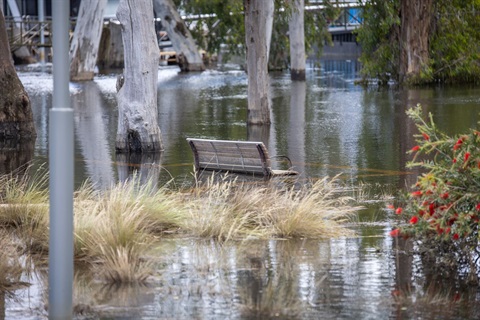Councils to join forces on flood recovery funding red tape
Published on 18 May 2023

Campaspe Shire Council has supported collaboration with Buloke, Gannawarra, Loddon and Swan Hill councils to raise concerns with the state and federal governments about challenges and complexities associated with current flood recovery funding arrangements, and the need for certainty about future funding.
Campaspe Shire Council Mayor Cr Rob Amos said that recent discussions among the mayors and chief executive officers of the five councils had highlighted several shared concerns about red tape, blockages and delays.
“Many of our concerns relate to the complexity and constraints associated with funding systems and processes,” Cr Amos said.
“Other concerns relate to uncertainty about whether requested funding to repair the full scope of damaged assets will be honoured and provided in a timely fashion.
“There is also a need to gain clarity around the timing of the Victorian Government’s commitment to assess the operational and infrastructure arrangements at Lake Eppalock.”
Some of the key challenges being experienced by the councils include:
Lack of certainty of requested funding
“Conversations earlier this year with Victorian Government representatives indicated that councils may only receive 80 per cent of requested funding for repairing flood-damaged assets. However, as a result of our ongoing advocacy, recent indications from the State suggest that councils are now likely to receive 100 percent of eligible claims. While this is welcome verbal news, we will continue to advocate for a more transparent and fit-for-purpose system that removes ambiguity on claims for genuine damage suffered by natural disasters,” Cr Amos said.
Lack of timeliness of requested funding
“There is inconsistency in the timing of advance funding being received by councils. The upfront and ongoing costs associated with flood recovery are significant. Councils need this urgent funding in a timely manner so they can expedite the repair of roads and other infrastructure as quickly as possible. This is particularly important ahead of the upcoming harvest season.”
Systemic / process constraints
“There are concerns and anecdotal information suggesting that councils are only allowed to lodge Disaster Relief Fund Australia (DRFA) claims in $500,000 increments. This means that if a council has $40 million worth of claims for example, it would have to lodge 80 claims. This kind of red tape only takes Council staff resources away from where they are needed and hampers the ability of councils to manage flood recovery efficiently and effectively.”
The need for ‘betterment’
“DRFA funding only allows for damaged infrastructure to be repaired to pre-flood condition and does not allow for “betterment” of the asset. This could increase a council’s public liability risk because the repair works they undertake may not align with their Road Management Plan it if specifies a higher standard,” Cr Amos said.
“By highlighting current concerns and challenges with the flood recovery funding arrangements, we aim to remove confusion, complexity and constraints associated with funding systems and processes, and create clarity, certainty, and consistency for councils to address urgent flood-related needs and priorities while also continuing to deliver more than 100 different services to their communities every day”.